Just for the 231 EnvPlan students...
30 Multiple Choice
30 True/False
I also added a few old Quiz questions on the Lecture Notes Page
Bring your own pencils and come on time
28 February 2010
Korean War Memorial copyright
I am rather stunned by this court ruling and admit that I can't imagine what it must mean for using photographs to teach landscape architecture.
LA in the news
Sometimes it can be pretty hard for the landscape architect on a project to get mentioned in the paper at all.
How we got the Ahwanees
Here is an old article from Western Cities Magazine describing how the Ahwanee Principles were developed.
27 February 2010
Snowy study distractions
So, if want to think about test concepts without studying, here are some time wasters that will seem productive even if they aren't.
- The USDA has a site about NJ Invasive species that include mitten crabs and flathead catfish.
- Wikipedia has an entry that lists all of the official State Soils. Wisconsin's even has its own song.
- EPA has a site where you can Surf Your Watershed.
- Here is an interactive Topo Map server. You can explore coastal Louisiana looking for the rare contour line or climb the Sierras looking for a flat spot.
- You could learn more about Fritz Steiner or Phil Lewis.
- You can read the NRI for Berkeley Heights. (NRIs are on Test 2 but the physical landscape information in the NRI is very Test 1)
26 February 2010
Gated Homes and the Geography of Exclusion in Puerto Rico
Rutgers Geography program has a great talk coming up that may be off special interest to the Advanced Geomatics Class.
“Gated Homes and the Geography of Exclusion in Puerto Rico.”
by
Zaire Dinzey-Flores
Assistant Professor
Latino & Hispanic Caribbean Studies & Dept of Sociology
Rutgers University
Time: 2 pm
Talk: B 115 Lucy Stone Hall
Reception will follow
Reception: B231
“Gated Homes and the Geography of Exclusion in Puerto Rico.”
by
Zaire Dinzey-Flores
Assistant Professor
Latino & Hispanic Caribbean Studies & Dept of Sociology
Rutgers University
Time: 2 pm
Talk: B 115 Lucy Stone Hall
Reception will follow
Reception: B231
24 February 2010
3 Landscapes: Elijah Huge
LiveBlog: Elijah Huge
Elijah Huge, Architect
Contrived Environments
Leads both a student studio (North Studio) and a separate small professional studio (Periphery)
SplitFrame at Mattebeseck Reserve in CT was a design-build project
The project sequence was influenced by the site and created a viewing deck that allowed visual access to the water while creating a structure that reflected the unique characteristics of the place
Intertidal
In Cape Cod Periphery worked on a comeptition project at Buzzards Bay Village
The centerpiece was a town green that, it was felt, should be more about water than land
They created a series of forms and voids that allowed the tide to create a daily drama as it flowed in and out
Tangshan Earthquake Memorial Park
Bundalow
A bamboo project at the Schuykill Center
Sukkah
His students designed and built a Sukkah at Weslyan
While initially unfamiliar with the details, they were offered some rabbinic code and encouraged to design something that could be erected every year
The final design was a series of arches which blurred the distinction between walls and ceiliing
Part of the goal is to treat architecture as something that isn't clearly defined - none of these projects have doors
The tectonics and materiality finds a commonality with us as landscape architects and designers
Contrived Environments
Leads both a student studio (North Studio) and a separate small professional studio (Periphery)
SplitFrame at Mattebeseck Reserve in CT was a design-build project
The project sequence was influenced by the site and created a viewing deck that allowed visual access to the water while creating a structure that reflected the unique characteristics of the place
Intertidal
In Cape Cod Periphery worked on a comeptition project at Buzzards Bay Village
The centerpiece was a town green that, it was felt, should be more about water than land
They created a series of forms and voids that allowed the tide to create a daily drama as it flowed in and out
Tangshan Earthquake Memorial Park
Bundalow
A bamboo project at the Schuykill Center
Sukkah
His students designed and built a Sukkah at Weslyan
While initially unfamiliar with the details, they were offered some rabbinic code and encouraged to design something that could be erected every year
The final design was a series of arches which blurred the distinction between walls and ceiliing
Part of the goal is to treat architecture as something that isn't clearly defined - none of these projects have doors
The tectonics and materiality finds a commonality with us as landscape architects and designers
A day of talks
Today at Rutgers you can see:
The only bad choice would be to stay at home.
- Elijah Huge, Contrived Environments
- Peter Galison - 'What Machines Demand: Ink Blots and Purposeful Circuits'
- Cornel West on 'Race and Democracy in the Age of Obama'
- Majora Carter - 'Green the Ghetto'
The only bad choice would be to stay at home.
Lecture Today: Elijah Huge Contrived Environments
Department of Landscape Architecture | Spring 2010 Lecture Series
Wednesday, February 24, 3:55 in Cook Douglass Lecture Hall, Room 110
Elijah Huge, Architect
Contrived Environments
Eschewing traditional disciplinary boundaries between architecture and landscape design, Periphery and North Studio pursue projects which strive to address the built environment as a collection of interconnected organic, synthetic, and regulatory conditions. These contrived environments are designed to reveal or redirect landscape patterns and processes within specific sites or constructed situations. In what is perhaps a curious
inversion, Periphery is a professional design entity working primarily on speculative projects, while North Studio is an academic initiative that is committed to seeing work built. Initiated in 2006, North Studio works out of Wesleyan University's historic Center for the Arts (CFA), designed by the office of Kevin Roche and John Dinkeloo. A nationally-recognized, landscape-focused atelier, North Studio operates as a contemporary variation on the traditional Beaux-Arts model of architectural practice and education,
undertaking projects with non-profit and public clients. Focusing on relationships between architecture and landscape, each project is expected to balance three objectives: the production of relevant design research,
real-world testing of ideas incubated in the studio, and the implementation of community-based, sustainable built work.
Elijah Huge is an architect and director of the design firm Periphery. Exploring the interactions between landscape, regulatory conditions, and architecture, his work includes award-winning competition entries for the High Line (New York, NY), the Bourne Bridge|Park (Bourne, MA), and the Tangshan Earthquake Memorial (Tangshan, China). His writings and design work have been featured in Praxis, Thresholds, Perspecta, Architectural Record, Landscape Architecture, Dwell, Journal of Architectural Education, and Competitions.
A graduate of the Yale School of Architecture, Elijah Huge received the AIA Henry Adams Medal and was editor of Perspecta 35: Building Codes. He is currently a Visiting Scholar at the University of California, Berkeley and Assistant Professor of Art at Wesleyan University. At Wesleyan, he leads the architecture studio track in the Department of Art & Art History and the North Studio atelier. Focused on developing and producing research and conceptually driven projects with nonprofit and public clients, North Studio is both a locus for undergraduate design education within the context of Wesleyan University's liberal arts curriculum and collaborative committed to seeing work built.
23 February 2010
More Stop the Beach Renourishment
Pruned has a link and fun photo for that pending SCOTUS case, Stop the Beach Renourishment Inc. v. Florida Department of Environmental Protection. I am starting to think it is going to be a high profile decision, and it is going to be treated as one of the leading indicators for a post-sea-level-rise legal environment.
22 February 2010
Public records
John Reiser writes about how some folks in North Carolina want to obscure some public records. Remember, the same information has always been public, just not as easy to get. Back when I was a kid you had to use the phonebook to find out where someone lived.
21 February 2010
20 February 2010
Does urban parkland help or hurt the environment?
The answer is a little more complicated than it might at first appear. Then again, I suspect that our regular readers won't find anything surprising in this story except for the great photo.
19 February 2010
An empty suburb
On our field trips to Boston, we visit Olmsted's planning neighborhood at World's End. It never got finished and that is part of what makes it great. Now, BLDG BLOG is taking a tour of the partially built California City.
Another great Rural Studio project
Auburn's Rural Studio gets undergraduates intimately involved in the design and construction of real buildings that serve their community. It remains a famous program that continues to amaze me with its ability to impact students and the community while demonstrating just how good a state school can be. (Go SEC!)
Their latest project is an animal shelter (link fixed) that is featured on Daily Dose. Check it out.
Their latest project is an animal shelter (link fixed) that is featured on Daily Dose. Check it out.
Shaping the 'City' of New Jersey
Rutgers is hosting an interesting meeting on Friday, April 16th. Thanks to the generosity of the GR Dodge Foundation the meeting is free, but registration is required.
James Corner to design the Atlanta BeltLine
ASLA's The DIRT reports that Field Operations and Perkins+Will have been hired for Atlanta's BeltLine, a major green infrastructure project. If you liked the High Line, this will probably like that but about 22 miles longer. And warmer.
18 February 2010
The Tarrgum on Planning and Design
The front page of today's Daily Targum (The Rutgers campus paper) has two EP&D stories above the fold.
First, Franklin Township has launched an Easton Avenue Corridor Study.
Second, the University is taking a step back from the Greening of College Avenue.
Here is the operative quote:
First, Franklin Township has launched an Easton Avenue Corridor Study.
Second, the University is taking a step back from the Greening of College Avenue.
Here is the operative quote:
“All of the other projects that we bring to you for your approval — the dining hall on [Livingston] campus, the proteomics building and the Nelson [Biology Laboratories C-wing] all come with revenue streams …” said University President Richard L. McCormick. “There’s no revenue stream for the greening of College Avenue unless you charge students for walking past bushes and trees.”
17 February 2010
LiveBlog: Jim Titus on "Can we prepare for a rising sea?"
Jim Titus, Climate Change Division, U.S. EPA
"Can we prepare for a rising sea?"
2010 Spring Environmental Geomatics Lecture
Words fail to capture much of this one - but the comments were offered to get us thining and not tp represent any official preferences for policy or funding decisions
No matter what you think about the science, let’s just imagine what we would do if it happens.
If you are a risk manager type, you probably have to think about that uncertainty.
There are generally 3 approaches - retreat, armor, elevate (you could accommodate, but how far does that really get you?)
3 factors for wetlands ecosystems: Topography, wetland accretion, shore protection structures
A rise faster than 2mm/yr presents the possibility of losing wetlands that can’t migrate inland fast enough. SLR is now a threat to septic tanks and development linked with them, but that has also pushed development into tighter bands of development along the shore.
Is it a taking if the government says that you can't build because it is going to be underwater in 30 years? Yes. But is it a taking if you can't build a bulkhead?
Long Beach Township - a govt nourished dune blocked someone's view and they got $200k
This summer there will be a new SCOTUS decision: Stop the Beach Nourishment Inc. vs. Florida Department of Environmental Protection
Texas has now recognized the rolling easement, but the state courts may still change things - Texas is unusual
Where you are matters: Maryland is changing from bulkheads -> revetments -> living shoreline
Take home: Maybe we don't need to kick people out and we don't need to get tough, but maybe we do need to establish the rules of the game for a generation or 2 from now to frame the responses that they will have to take
"Can we prepare for a rising sea?"
2010 Spring Environmental Geomatics Lecture
Words fail to capture much of this one - but the comments were offered to get us thining and not tp represent any official preferences for policy or funding decisions
No matter what you think about the science, let’s just imagine what we would do if it happens.
If you are a risk manager type, you probably have to think about that uncertainty.
There are generally 3 approaches - retreat, armor, elevate (you could accommodate, but how far does that really get you?)
3 factors for wetlands ecosystems: Topography, wetland accretion, shore protection structures
A rise faster than 2mm/yr presents the possibility of losing wetlands that can’t migrate inland fast enough. SLR is now a threat to septic tanks and development linked with them, but that has also pushed development into tighter bands of development along the shore.
Is it a taking if the government says that you can't build because it is going to be underwater in 30 years? Yes. But is it a taking if you can't build a bulkhead?
Long Beach Township - a govt nourished dune blocked someone's view and they got $200k
This summer there will be a new SCOTUS decision: Stop the Beach Nourishment Inc. vs. Florida Department of Environmental Protection
Texas has now recognized the rolling easement, but the state courts may still change things - Texas is unusual
Where you are matters: Maryland is changing from bulkheads -> revetments -> living shoreline
Take home: Maybe we don't need to kick people out and we don't need to get tough, but maybe we do need to establish the rules of the game for a generation or 2 from now to frame the responses that they will have to take
Budding Arborists in the Bronx
The NY Times has posted a video showing how New Jersey arborist, Mark Chiolm, is teaching tree climbing and tree maintenance in the Bronx.
Small town news
A recent project in Spotswood by the LA department gets a quick mention in the Sentinel.
16 February 2010
2010 Spring Environmental Geoamtics Lecture
Department of Landscape Architecture
Spring 2010 Lecture Series
Wednesday, February 17, 3:55 in Cook Douglass Lecture Hall Room 110
Jim Titus, Climate Change Division, U.S. EPA
"Can we prepare for a rising sea?"
Bio: Jim Titus has been studying the effects of rising sea level and urging people to prepare for the consequences since 1982. He has a BA in economics from University of Maryland and a JD from Georgetown University Law Center. He also helped elevate the family cottage on the bay side of Brant Beach by two feet. His most recent publication creates sea level rise planning maps, and estimates that more than 60 percent of Atlantic coast lowlands are likely to be developed and protected from the rising sea under current policies.
Spring 2010 Lecture Series
Wednesday, February 17, 3:55 in Cook Douglass Lecture Hall Room 110
Jim Titus, Climate Change Division, U.S. EPA
"Can we prepare for a rising sea?"
Bio: Jim Titus has been studying the effects of rising sea level and urging people to prepare for the consequences since 1982. He has a BA in economics from University of Maryland and a JD from Georgetown University Law Center. He also helped elevate the family cottage on the bay side of Brant Beach by two feet. His most recent publication creates sea level rise planning maps, and estimates that more than 60 percent of Atlantic coast lowlands are likely to be developed and protected from the rising sea under current policies.
Map-making video
A graphic artist has created a great time-lapse video showing how he used Illustrator to make a tourist map for a Florida attraction. Digital Urban has both the video and related links. It is great to see the process revealed.
Great talk!
Green The Ghetto – and how much it won’t cost us
Douglass Residential College’s 2010 “Women in the Era of Globalization” lecture series presents Majora Carter, noted environmental activist and MacArthur award winner. Ms. Carter’s work is devoted to sustainable development and environmental justice. Her holistic vision links green building, livable neighborhoods, and anti-poverty efforts. After linking government, industry, environmental and community groups to develop a park in the Hunt’s Point neighborhood of the Bronx, she started the Sustainable South Bronx organization. She is now head of a consulting firm the Majora Carter Group which works to find innovative solutions to environmental degradation and poverty together. Douglass is pleased to bring Majora Carter’s inspiring vision to Rutgers and the entire New Brunswick community.
Date: February 24, 2010
Time: 7:00 p.m.
Location: Trayes Hall, Douglass Campus Center, 100 George Street, New Brunswick, NJ
To download flyer click here.
For more information on Majora Carter, visit www.majoracartergroup.com
Or just watch her TED talk
But you should plan on arriving early, since I expect a large crowd.
14 February 2010
Snowday: Big snowballs on the Cook Campus
Some people waste snowdays and others make them something special. Our students really made something big, even if it was just snowballs. These beautiful photographs by James Brosius capture this great example of temporary public art on the lawn areas around Passion Puddle. More photos are on his album on Facebook.
12 February 2010
Post #2000
Blogspot reports that this is my 2,000th post on Places and Spaces. Not much else to say.
Individual Actions = Global Change International Photography Contest
The Center for International Social Work is pleased to announce its first annual Individual Actions = Global Change International Photography Contest. The 2010 theme is Climate Change and Poverty.
All submissions should be in the form of a pair of photos: The first photo should represent a depiction of the challenge of climate change, poverty or the interconnectedness of the two in your community. The
second photo should exemplify the opportunity for action. The contest is open to all individuals anywhere in the world. Photos must be taken and submitted by the same individual. The deadline for submissions is March 24th.
For more information and guidelines visit
http://socialwork.rutgers.edu/CentersandPrograms/CISW.aspx
All submissions should be in the form of a pair of photos: The first photo should represent a depiction of the challenge of climate change, poverty or the interconnectedness of the two in your community. The
second photo should exemplify the opportunity for action. The contest is open to all individuals anywhere in the world. Photos must be taken and submitted by the same individual. The deadline for submissions is March 24th.
For more information and guidelines visit
http://socialwork.rutgers.edu/CentersandPrograms/CISW.aspx
11 February 2010
Gift idea?
For that planner or urban designer in your life. You could get them a tie for Valentine's Day.
SUBURBIA TRANSFORMED, One Garden at a Time
SUBURBIA TRANSFORMED, One Garden at a Time:
EXPLORING THE AESTHETICS OF LANDSCAPE EXPERIENCE IN THE
AGE OF SUSTAINABILITY
A Competition for Built Residential Landscapes
Through a juried competition, Suburbia Transformed, One Garden at a Time will assemble contemporary projects achieving the goal of exploring green technologies within the context of the aesthetics of human landscape experience on small residential sites. The competition, sponsored by the James Rose Center and co-sponsored by NJASLA, Garden Design Magazine, and Rutgers, the State University of New Jersey, will result in a traveling exhibition and catalogue. The emphasis is on how emerging sustainable strategies and tactics are used to create human landscape experiences that are beautiful, inspiring, perhaps profound; and which might serve as examples for transforming the suburban residential fabric, one garden at a time.
Outstanding projects will be selected by an international jury of academics and practitioners including:
Shane Coen, Principal, Coen+Partners, Minneapolis, New York
Patrick M. Condon, Professor, James Taylor Chair in Landscape and Livable Environments, University of British Columbia
Gary R. Hilderbrand, FASLA, FAAR, Principal, Reed Hilderbrand Associates Inc., Watertown, MA
Elizabeth K. Meyer, FASLA, Associate Professor of Landscape Architecture, University of Virginia
Dean Cardasis, FASLA, Professor of Landscape Architecture, Rutgers, the State University of New Jersey; Principal, Cave Hill Landscape Architects
For detailed information and/or to enter see http://www.jamesrosecenter.org
EXPLORING THE AESTHETICS OF LANDSCAPE EXPERIENCE IN THE
AGE OF SUSTAINABILITY
A Competition for Built Residential Landscapes
Through a juried competition, Suburbia Transformed, One Garden at a Time will assemble contemporary projects achieving the goal of exploring green technologies within the context of the aesthetics of human landscape experience on small residential sites. The competition, sponsored by the James Rose Center and co-sponsored by NJASLA, Garden Design Magazine, and Rutgers, the State University of New Jersey, will result in a traveling exhibition and catalogue. The emphasis is on how emerging sustainable strategies and tactics are used to create human landscape experiences that are beautiful, inspiring, perhaps profound; and which might serve as examples for transforming the suburban residential fabric, one garden at a time.
Outstanding projects will be selected by an international jury of academics and practitioners including:
Shane Coen, Principal, Coen+Partners, Minneapolis, New York
Patrick M. Condon, Professor, James Taylor Chair in Landscape and Livable Environments, University of British Columbia
Gary R. Hilderbrand, FASLA, FAAR, Principal, Reed Hilderbrand Associates Inc., Watertown, MA
Elizabeth K. Meyer, FASLA, Associate Professor of Landscape Architecture, University of Virginia
Dean Cardasis, FASLA, Professor of Landscape Architecture, Rutgers, the State University of New Jersey; Principal, Cave Hill Landscape Architects
For detailed information and/or to enter see http://www.jamesrosecenter.org
09 February 2010
Lesss greening than originally hoped
The Daily Targum reports that budget realities have forced the Greening of College Ave to get scaled back some:
Upcoming transformations to the College Avenue and Livingston campuses would have a dramatic impact on the feel of the New Brunswick campus, he said.
But the College Avenue Greening Project has been scaled back from plans, which called for a portion of the street to be confined to buses and emergency vehicles.
“I’m sort of deflated by [the street remaining two-ways], because where I started was a vision for a pedestrian College Avenue without vehicular traffic,” McCormick said.
he Greening Project will now include a major landscape architecture renovation, he said.
“We will replace the ugly bus stop in front of the College Avenue Gym, we will get rid of the parking meters on College Avenue … and it will look a whole lot better, but the basic transportation aspects will not be changed,” McCormick said.
08 February 2010
Emergency Services
It seems like that ever since I started reading the Cape May Herald last fall, there has hardly been a day with mentioning some sort of emergency services or OEM activity.
Spring 2010 Environmental Planning Lecture
"Foreclosed Opportunity? Rethinking Neighborhood Change in the Wake of the Foreclosure Crisis"
Kathe Newman, PhD, Assistant Professor Edward J. Bloustein School of Planning and Public Policy
Wed. Feb 10, 2010, 3:55 PM
Cook Douglass Lecture Hall 110
Foreclosure is devastating neighborhoods and communities across the country. In this talk I explore what the foreclosure crisis means in New Jersey. I show what we know about the concentration of foreclosed properties and what foreclosure means for renters, borrowers, and communities. I then consider the possibilities that the foreclosure crisis presents for reconceptualizing neighborhood revitalization.
(Weather permitting)
Change of schedule
Please note that the previously advertised lecture,"Managing Climate Change: Prospects and Limits of International Action," by Dr. Ted Parson, has been postponed to May 12th.
Date: Wednesday, May 12th, 2010
Time: 12:30 PM to 2:00 pm
Location: Blake Hall, Room 131, Cook Campus
Date: Wednesday, May 12th, 2010
Time: 12:30 PM to 2:00 pm
Location: Blake Hall, Room 131, Cook Campus
07 February 2010
04 February 2010
Managing Climate Change: Prospects and Limits of International Action
PLEASE NOTE THE CHANGED TIME AND DATE
"Managing Climate Change: Prospects and Limits of International Action"
Dr. Ted Parson, Professor
Joseph L. Sax Collegiate Professor of Law, Natural Resources & Environment
University of Michigan
Date: Wednesday, May 12th, 2010
Time: 12:30 PM to 2:00 pm
Location: Blake Hall, Room 131, Cook Campus (http://search.rutgers.edu/buildings.html?q=blake)
Click here for additional information
For questions and further information, please contact Kristen Drusjack atdrusjack@aesop.rutgers.edu> drusjack@aesop.rutgers.edu or
732-932-9153 ext 301.
"Managing Climate Change: Prospects and Limits of International Action"
Dr. Ted Parson, Professor
Joseph L. Sax Collegiate Professor of Law, Natural Resources & Environment
University of Michigan
Date: Wednesday, May 12th, 2010
Time: 12:30 PM to 2:00 pm
Location: Blake Hall, Room 131, Cook Campus (http://search.rutgers.edu/buildings.html?q=blake)
Click here for additional information
For questions and further information, please contact Kristen Drusjack at
732-932-9153 ext 301.
OK City is OK
Ever since the NBA's Thunder started rumbles about Oklahoma City, I have been a bit curious about this new booming metropolis. The NY Times Travel section featured it in 2008, but then things got quiet again for a bit.
It is back in the headlines now for its new and future development downtown. The TImes moved it into the Real Estate section this past week and Fast Company writes that: "If "America is the Saudi Arabia of natural gas," as T. Boone Pickens puts it, then Oklahoma City is its Riyadh."
It is back in the headlines now for its new and future development downtown. The TImes moved it into the Real Estate section this past week and Fast Company writes that: "If "America is the Saudi Arabia of natural gas," as T. Boone Pickens puts it, then Oklahoma City is its Riyadh."
03 February 2010
Lecture Today:Jason Travers, Artist
Jason Travers, Artist
Wednesday, February 3, 4 pm, Cook Douglass Lecture Hall, room 101
Jason Travers will be showing images of his recent, often landscape-based work and discussing the development of his ideas and working methods.
Jason Travers: BFA, Painting, The Art Institute of Boston; MFA, Painting, American University. Travers teaches at Rhode Island College and Bridgewater State College and is represented by Lenore Gray Gallery in Providence. His work has recently been exhibited at the Lascano Gallery in Great Barrington, MA and the Wheeler Gallery in Providence. He had recent one-man exhibitions at Kimbal Jenkins Gallery in Concord, NH and Lenore Gray Gallery. In 2006, Travers was the recipient of a painting fellowship from the Rhode Island State Council on the Arts. Travers lives in Providence, Rhode Island. (RISD.org)
"By using subtle, vibrating color, the paintings presented in this exhibition are evocative of the natural processes of air or water. These canvases are constructed diptychs, which suggest the mythical dialog of dualities. By using either multi-panel paintings or missing pieces, the paintings exert a physical presence. These sculptural paintings appear simple, but require time to let the subtleties open to the senses. They do not hang passively on the wall, but play with the viewer's spatial awareness. These paintings are quiet, meditative, often humorous, and poetic." (Jill Coldren Gallery, Concord, NH, 2007)
Wednesday, February 3, 4 pm, Cook Douglass Lecture Hall, room 101
Jason Travers will be showing images of his recent, often landscape-based work and discussing the development of his ideas and working methods.
Jason Travers: BFA, Painting, The Art Institute of Boston; MFA, Painting, American University. Travers teaches at Rhode Island College and Bridgewater State College and is represented by Lenore Gray Gallery in Providence. His work has recently been exhibited at the Lascano Gallery in Great Barrington, MA and the Wheeler Gallery in Providence. He had recent one-man exhibitions at Kimbal Jenkins Gallery in Concord, NH and Lenore Gray Gallery. In 2006, Travers was the recipient of a painting fellowship from the Rhode Island State Council on the Arts. Travers lives in Providence, Rhode Island. (RISD.org)
"By using subtle, vibrating color, the paintings presented in this exhibition are evocative of the natural processes of air or water. These canvases are constructed diptychs, which suggest the mythical dialog of dualities. By using either multi-panel paintings or missing pieces, the paintings exert a physical presence. These sculptural paintings appear simple, but require time to let the subtleties open to the senses. They do not hang passively on the wall, but play with the viewer's spatial awareness. These paintings are quiet, meditative, often humorous, and poetic." (Jill Coldren Gallery, Concord, NH, 2007)
Great Falls
Rutgers' Steven Handel is getting some great attention for his work on Great Falls of Paterson.
02 February 2010
Sample topo maps
After talking about the free USGS topographic quads for NJ in class, I wanted to share some different scenes from around New Jersey that would be of interest. Just click and they'll expand.
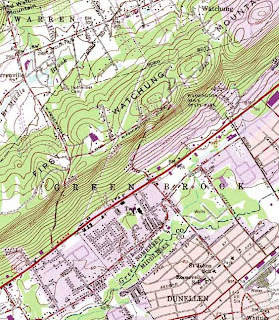
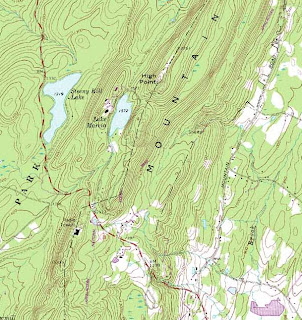
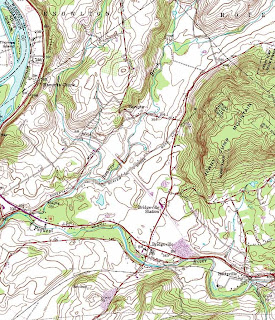
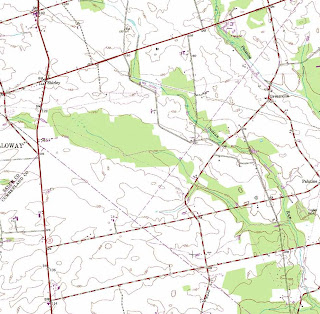


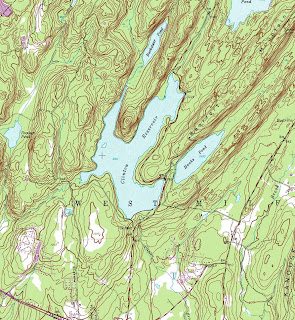

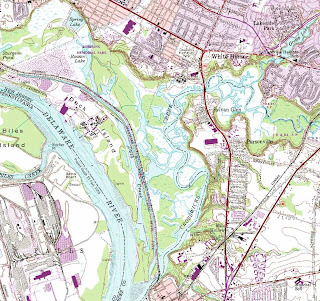 A special thanks goes out to Mike Siegel and the Rutgers Cartography Lab. This is a great resource for students and for pros.
A special thanks goes out to Mike Siegel and the Rutgers Cartography Lab. This is a great resource for students and for pros.
There is also an interesting guide to reading topographic maps from How Stuff Works.








 A special thanks goes out to Mike Siegel and the Rutgers Cartography Lab. This is a great resource for students and for pros.
A special thanks goes out to Mike Siegel and the Rutgers Cartography Lab. This is a great resource for students and for pros.There is also an interesting guide to reading topographic maps from How Stuff Works.
01 February 2010
Privately owned public space map
Ever since Minnesota's Kristine Miller wrote her book, Designs on the public: the private lives of New York's public spaces, I started paying closer attention to the hidden public spaces in various cities. Like NIMBY and LULUs, they need a good name to catch on so some people are calling them Privately Owned Public Open Spaces or POPOS. So it caught my eye when Strange Maps blogged a map of POPOS in San Francisco. As they point out, some of these a well-kept secrets. Well, they were.
Subscribe to:
Posts (Atom)







